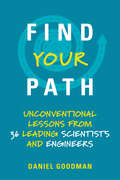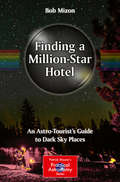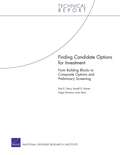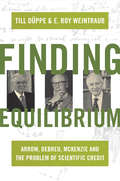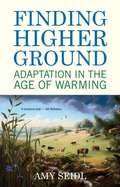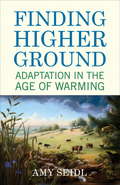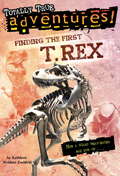- Table View
- List View
Finanzierung für Ingenieure (essentials)
by Ekbert HeringDie meisten Ingenieure in der Praxis werden vor Finanzierungsaufgaben gestellt und müssen hierfür die optimalen Finanzierungsmöglichkeiten bereitstellen. Deshalb werden in diesem Band die Finanzierungsarten und die Finanzierungsinstrumente vorgestellt. Es wird gezeigt, welche wichtigen Informationen eine Finanzanalyse bieten kann und wie eine Finanzplanung für ein Unternehmen erstellt wird.
The Finch in My Brain: How I forgot how to read but found how to live
by Martino Sclavi'Whenever I see Martino I am reminded of how little I know about life and death compared to him. How we don't know what is within us or what may lie on the other side. I hope it's as magical and beautiful as this book.' --Russell BrandWhen film producer Martino Sclavi began experiencing intense headaches, he attributed them to his frenetic lifestyle. As it turned out, he had grade 4 brain cancer and was given 18 months to live. After undergoing brain surgery - while awake - Martino found he had lost the ability to recognise words. His response was to close his eyes and begin to move his fingers across the keyboard to write this, an account of life before diagnosis and since. Defying all predictions Martino is still very much alive, words read out to him by the monotone of a computerised voice he calls Alex. But he must now live in a new way. This book - that he has written but cannot read - charts the effects of his experience: on his relationship with his young son, his marriage, his work and with himself. In the wake of his illness, everything must be reconfigured and Martino is made to question the habits, dreams and beliefs of his old life and confront the present. What he finds is strange and beautiful. Searching for the words between life and death, Sclavi shows that with determination and a subtle, persistent sense of humour, it is possible to change the story of our lives.
The Finch in My Brain: How I forgot how to read but found how to live
by Martino Sclavi'It's eerily joyful to write a foreword for Martino Sclavi's book because five years ago I accepted that he was going to die.' Russell Brand. Diagnosed with fatal brain cancer, the treatment that follows renders the writer of this extraordinary memoir unable to recognise words. This is the inspiring story he can no longer read. With a foreword by Russell Brand.This is the story of a successful Italian-born, London-based film writer who is suddenly, wholly unexpectedly diagnosed with stage four brain cancer. The prognosis is bad: there's a 98% likelihood he'll be dead within 18 months. He undergoes two operations, including one in which he must remain awake throughout. Part of his brain is removed, the part that enables us to recognise written words - to read. As someone who relies on words for their livelihood, their very identity, this presents impossible questions as to what happens next. Defying all predictions, Martino is still very much alive five years on, and is writing and being read to by a monotonous computerised voice he calls Alex. His marriage suffered, his relationship with his young son - whom he will never read bedtime stories to again - must be reconfigured and he is made to question all that his previous life gave him, along with his habits, dreams and beliefs.As Sclavi faces the reality of the narrative he's been presented by doctors, he shows us that with determination, it is possible to change that narrative, and in doing so inspires and empowers us all to believe that it is possible to change the story of our lives.'Whenever I see Martino I am reminded of how little I know about life and death compared to him. How we don't know what is within us or what may life on the other side. I hope it's as magical and beautiful as this book.'Russell Brand.(P)2017 Hodder & Stoughton Limited
Find The Constellations
by H. A. ReyContaining star charts, a guide to the constellations, and details about seasons and the movement of the objects we see in the sky, this classic book makes H. A. Rey’s passion for astronomy evident on every page. <p><p> New updates concentrate on the planetary and solar system information in the latter part of the book. Facts and figures for each planet have been revised, and new scientific information has been added, such as Pluto’s reclassification as a dwarf planet. There's also a brand-new online resource that allows readers to track the positions of the planets in the night sky till the year 2100!
Find More Birds: 111 Surprising Ways To Spot Birds Wherever You Are
by Heather Wolf“Packed with excellent photos and tips, deeply relatable anecdotes, and a palpable sense of joy, this gem of a book will make you a better birder.”—Rosemary Mosco, author of A Pocket Guide to Pigeon Watching A gorgeously photographed trove of 111 ingenious tips for seeing more birds wherever you are—from crowd favorites (hummingbirds, owls, eagles) to species you’ve never spotted before Seeing more birds than you ever imagined and witnessing exciting avian drama is possible—whether you’re on the go or in your own neighborhood, local park, or backyard. As Heather Wolf explains, it all comes down to how you tune in to the show happening around you, the one in which birds—highly skilled at staying under the radar—are the stars. In Find More Birds, Heather shares her very best tactics—and the jaw-dropping photographs they helped her capture. Look for birds at their favorite “restaurants”— from leaf litter to berry bushes, and ball fields to small patches of mud. Watch for “tree bark” that moves . . . you may find it has feathers. Try simply sitting on the ground for a revealing new perspective. Plus, special tips point the way to crowd favorites such as hummingbirds, owls, and eagles—and can’t-miss bird behaviors. As your senses sharpen and “noticing” becomes second nature, Find More Birds will turn your daily routines into bird-finding adventures, too. Whether you’re strolling down the block or parking your car, you never know what will surprise you next!
Find the Constellations
by H.A. ReyA classic for all ages—the &“wonderful&” guide to the night sky by the creator of Curious George (Horn Book). Containing star charts, a guide to the constellations, and details about seasons and the movement of the objects we see in the sky, this classic book makes H. A. Rey&’s passion for astronomy evident on every page. New updates concentrate on the planetary and solar system information in the latter part of the book. Facts and figures for each planet have been revised, and new scientific information has been added, such as Pluto&’s reclassification as a dwarf planet. There's also a brand-new online resource that allows readers to track the positions of the planets in the night sky till the year 2100. &“An excellent introduction to the heavens, to satisfy and stimulate a child&’s interest…a very useful book.&”—Kirkus Reviews &“Persuades the reader that astronomy is not only easy—it&’s fun.&”—The New York Times &“Excellent.&”—Saturday Review
Find Your Path: Unconventional Lessons from 36 Leading Scientists and Engineers (The\mit Press Ser.)
by Daniel GoodmanScientists offer personal accounts of the challenges, struggles, successes, U-turns, and satisfactions encountered in their careers in industry, academia, and government.This insightful book offers essential life and career lessons for newly minted STEM graduates and those seeking a career change. Thirty-six leading scientists and engineers (including two Nobel Prize winners) describe the challenges, struggles, successes, satisfactions, and U-turns encountered as they established their careers. Readers learn that there are professional possibilities beyond academia, as contributors describe the paths that took them into private industry and government as well as to college and university campuses. They discuss their varying preferences for solitary research or collaborative teamwork; their attempts to achieve work-life balance; and unplanned changes in direction that resulted in a more satisfying career. Women describe confronting overt sexism and institutional gender bias; scientists of color describe the experience of being outsiders in their field. One scientist moves from startup to startup, enjoying a career of serial challenges; another spends decades at one university; another has worked in academia, industry, and government. Some followed in the footsteps of parents; others were the first in their family to go to college. Many have changed fields, switched subjects, or left established organizations for something new. Taken together, these essays make it clear that there is not one path to a profession in science, but many.ContributorsStephon Alexander, Norman Augustine, Wanda Austin, Kimberly Budil, Wendy Cieslak, Jay Davis, Tamara Doering, Stephen D. Fantone, Kathleen Fisher, David Galas, Kathy Gisser, Sandra Glucksmann, Daniel Goodman, Renee Horton, Richard Lethin, Christopher Loose, John Mather, Richard Miles, Paul Nielsen, Michael O'Hanlon, Deirdre Olynick, Jennifer Park, Ellen Pawlikowski, Ethan Perlstein, Richard Post, William Press, Beth Reid, Jennifer Roberts, Jessica Seeliger, David Spergel, Ellen Stofan, Daniel Theobald, Shirley Tilghman, Jami Valentine, Z. Jane Wang, Rainer Weiss
Find Your Peace: Supernatural Solutions Beyond Science for Fear, Anxiety, and Depression
by Rodica MalosYour best prescription goes beyond science. This book will help transform your way of thinking and give you tools to change your life and even your eternity. It will help you cope with stress and others and change the world around you. Despite health care professionals&’ constant efforts to educate, entice, advise, convince, indoctrinate, and persuade patients with smooth talk, bribes, guilt, and manipulation to make people understand and follow medical advice, the results are often minimal. People continue to suffer from various diseases and chronic conditions. Many still die prematurely from high levels of stress caused by fear, worry, anxiety, and depression. Even with so much knowledge, the gaps in the way people manage stressors in their daily lives needs to be addressed. In Find Your Peace, Dr. Rodica Malos tackles this universal topic head-on. Brimming with medical research, basic brain chemistry, and scriptural wisdom, this powerful, encouraging book reveals how the divine design of the human body functions most perfectly when a person&’s thought life aligns with God&’s instructions (prescriptions beyond science). God&’s divine prescriptions and timeless truths will transform, comfort, sustain, and heal. Readers will learn to confront their fear, anxiety, and depression with supernatural resources and develop a healthier lifestyle full of blessings and peace.
Finding a Million-Star Hotel
by Bob MizonBob Mizon, one of the world's best known campaigners against the veil of light pollution that has taken away the starry sky from most of the world's population, takes readers to a hundred places in the UK and the USA where the wonders of the night sky might still be enjoyed in perfect or near-perfect night skies. Visiting small hotels and simple campsites, and savoring vast dark-sky reserves where the night sky is actively protected, The Million-Star Hotel celebrates the black skies of yesteryear - which may become a reality for more and more of us as modern technology reins in lighting and puts it only where needed. How can you prepare for your stay beneath the stars? What astronomy can you do during the daytime? What kind of equipment will you need? Questions such as these are answered, and if town dwellers return inspired - and, Bob hopes, also inspired to look with fresh eyes at their own local lighting - there is enough information here for them to equip themselves for some urban astronomy too.
Finding Candidate Options for Investment
by Russell D. Shaver Gaga Gvineria Justin Beck Paul K. DavisDescription of a methodology and a prototype tool, Building Blocks To Composite Options Tool (BCOT), for identifying investment options for defense capability areas. It ensures that a broad range of options is considered initially, then uses a screening technique to narrow the range to those meriting more-extensive assessment in a fuller portfolio-analysis framework. BCOT extends classic economics and operations-research techniques and suggests pragmatic approximations, particularly in capabilities-based planning.
Finding Darwin's God: A Scientist's Search for Common Ground Between God and Evolution
by Kenneth R. MillerFrom a leading authority on the evolution debates comes this critically acclaimed investigation into one of the most controversial topics of our times.
Finding Dinosaur Sue (Fountas & Pinnell Classroom, Guided Reading)
by J. C. KaneNIMAC-sourced textbook. A HUGE Discovery. Sue Hendrickson was born curious. One day that curiosity led her to the largest, most complete T. rex skeleton ever found.
Finding Einstein's Brain
by Dr Frederick E. LeporeAlbert Einstein remains the quintessential icon of modern genius. Like Newton and many others, his seminal work in physics includes the General Theory of Relativity, the Absolute Nature of Light, and perhaps the most famous equation of all time: E=mc2. Following his death in 1955, Einstein’s brain was removed and preserved, but has never been fully or systematically studied. In fact, the sections are not even all in one place, and some are mysteriously unaccounted for! In this compelling tale, Frederick E. Lepore delves into the strange, elusive afterlife of Einstein’s brain, the controversy surrounding its use, and what its study represents for brain and/or intelligence studies. Carefully reacting to the skepticism of 21st century neuroscience, Lepore more broadly examines the philosophical, medical, and scientific implications of brain-examination. Is the brain simply a computer? If so, how close are we to artificially creating a human brain? Could scientists create a second Einstein? This “biography of a brain” attempts to answer these questions, exploring what made Einstein’s brain anatomy exceptional, and how “found” photographs--discovered more than a half a century after his death--may begin to uncover the nature of genius.
Finding Equilibrium: Arrow, Debreu, McKenzie and the Problem of Scientific Credit
by Till Düppe E. Roy WeintraubThe remarkable story and personalities behind one of the most important theories in modern economicsFinding Equilibrium explores the post–World War II transformation of economics by constructing a history of the proof of its central dogma—that a competitive market economy may possess a set of equilibrium prices. The model economy for which the theorem could be proved was mapped out in 1954 by Kenneth Arrow and Gerard Debreu collaboratively, and by Lionel McKenzie separately, and would become widely known as the "Arrow-Debreu Model." While Arrow and Debreu would later go on to win separate Nobel prizes in economics, McKenzie would never receive it. Till Düppe and E. Roy Weintraub explore the lives and work of these economists and the issues of scientific credit against the extraordinary backdrop of overlapping research communities and an economics discipline that was shifting dramatically to mathematical modes of expression.Based on recently opened archives, Finding Equilibrium shows the complex interplay between each man's personal life and work, and examines compelling ideas about scientific credit, publication, regard for different research institutions, and the awarding of Nobel prizes. Instead of asking whether recognition was rightly or wrongly given, and who were the heroes or villains, the book considers attitudes toward intellectual credit and strategies to gain it vis-à-vis the communities that grant it.Telling the story behind the proof of the central theorem in economics, Finding Equilibrium sheds light on the changing nature of the scientific community and the critical connections between the personal and public rewards of scientific work.
Finding Fibonacci: The Quest to Rediscover the Forgotten Mathematical Genius Who Changed the World
by Keith DevlinIn 2000, Keith Devlin set out to research the life and legacy of the medieval mathematician Leonardo of Pisa, popularly known as Fibonacci, whose book Liber abbaci has quite literally affected the lives of everyone alive today. Although he is most famous for the Fibonacci numbers—which, it so happens, he didn't invent—Fibonacci's greatest contribution was as an expositor of mathematical ideas at a level ordinary people could understand. In 1202, Liber abbaci—the "Book of Calculation"—introduced modern arithmetic to the Western world. Yet Fibonacci was long forgotten after his death, and it was not until the 1960s that his true achievements were finally recognized.Finding Fibonacci is Devlin's compelling firsthand account of his ten-year quest to tell Fibonacci's story. Devlin, a math expositor himself, kept a diary of the undertaking, which he draws on here to describe the project's highs and lows, its false starts and disappointments, the tragedies and unexpected turns, some hilarious episodes, and the occasional lucky breaks. You will also meet the unique individuals Devlin encountered along the way, people who, each for their own reasons, became fascinated by Fibonacci, from the Yale professor who traced modern finance back to Fibonacci to the Italian historian who made the crucial archival discovery that brought together all the threads of Fibonacci's astonishing story.Fibonacci helped to revive the West as the cradle of science, technology, and commerce, yet he vanished from the pages of history. This is Devlin's search to find him.
Finding God in the Waves: How I Lost My Faith and Found It Again Through Science
by Mike Mchargue Rob BellFrom the host of the popular podcasts, The Liturgists Podcast and Ask Science Mike, a story of having faith, losing it, and finding it again through science--revealing how the latest in neuroscience, physics, and biology help us understand God, faith, and ourselves. What do you do when God dies? It's a question facing millions today, as science reveals a Universe that's self-creating, American culture departs from Christian social norms, and the idea of God begins to seem implausible at best and destructive at worst. Mike McHargue understands the pain of unraveling belief. In Finding God in the Waves, Mike tells the story of how his Evangelical faith dissolved into atheism as he studied the Bible, a crisis that threatened his identity, his friendships, and even his marriage. Years later, Mike was standing on the shores of the Pacific Ocean when a bewildering, seemingly mystical moment motivated him to take another look. But this time, it wasn't theology or scripture that led him back to God--it was science. In Finding God in the Waves, "Science Mike" draws on his personal experience to tell the unlikely story of how science led him back to faith. Among other revelations, we learn what brain scans reveal about what happens when we pray; how fundamentalism affects the psyche; and how God is revealed not only in scripture, but in the night sky, in subatomic particles, and in us. For the faithful and skeptic alike, Finding God in the Waves is a winsome, lucid, page-turning read about belonging, life's biggest questions, and the hope of knowing God in an age of science.From the Hardcover edition.
Finding God in the Waves: How I Lost My Faith and Found It Again Through Science
by Mike Mchargue Rob BellFrom the host of the popular podcasts, The Liturgists Podcast and Ask Science Mike, a story of having faith, losing it, and finding it again through science—revealing how the latest in neuroscience, physics, and biology help us understand God, faith, and ourselves. Forty-four percent of Americans will go through a major faith transition in their lives. And now, with church attendance on the decline and increasing cultural independence from Christian social norms, this trend has reached a tipping point: the fastest growing religion in America is "none." Mike McHargue understands the pain of unraveling belief. In Finding God in the Waves, Mike tells the story of how his Evangelical faith dissolved into atheism as he studied the Bible, a crisis that threatened his identity, his friendships, and even his marriage. Years later, Mike was standing on the shores of the Pacific Ocean when a bewildering, seemingly mystical moment motivated him to take another look. But this time, it wasn't theology or scripture that led him back to God—it was science. Full of insights about the universe, as well as deeply personal reflections on our desire for certainty and meaning, Finding God in the Waves is a vital exploration of the possibility for knowing God in an age of reason, and a signpost for where the practice of faith is headed in a secular age. Among other revelations, we learn what brain scans reveal about what happens when we pray; how fundamentalism affects the psyche; and how God is revealed not only in scripture, but in the night sky, in subatomic particles, and in us.From the Hardcover edition.
Finding Higher Ground: Adaptation in the Age of Warming
by Amy SeidlAn ecologist takes the uniquely positive--yet realistic--position that we can adapt and persist despite the inevitable effects of climate change. While much of the global warming conversation rightly focuses on reducing our carbon footprint, the reality is that even if we were to immediately cease emissions, we would still face climate change into the next millennium. In Finding Higher Ground, Amy Seidl takes the uniquely positive--yet realistic--position that humans and animals can adapt and persist despite these changes. Drawing on an emerging body of scientific research, Seidl brings us stories of adaptation from the natural world and from human communities. She offers examples of how plants, insects, birds, and mammals are already adapting both behaviorally and genetically. Within ten years, one plant species in a drought-stricken area has evolved to fit its life cycle into the shorter growing season. Red squirrels are breeding earlier to take advantage of the food supplied by an earlier spring. And some birds are migrating shorter distances, or not at all, as their northern habitats become milder. While some species will be unable to adapt to new conditions quickly enough to survive, Seidl argues that those that do can show us how to increase our own capacity for resilience. She tells of a young farmer experimenting with adaptive strategies for local crops, architects using biomimicry to design buildings that actually contribute to their surrounding ecosystems, and the establishment of decentralized and renewable energy banks. While Seidl admits that these efforts alone won't change the world, she hopes that taken together they can form the basis for a new, revolutionary set of ideas to live by, much like the efforts that brought about abolition, women's suffrage, and the eight-hour workday. In looking at climate change as an opportunity to establish new cultural norms, Seidl's perspective inspires readers to move beyond loss and offers a refreshing call to evolve.
Finding Higher Ground
by Amy SeidlWhile much of the global warming conversation rightly focuses on reducing our carbon footprint, the reality is that even if we were to immediately cease emissions, we would still face climate change into the next millennium. In Finding Higher Ground, Amy Seidl takes the uniquely positive--yet realistic--position that humans and animals can adapt and persist despite these changes. Drawing on an emerging body of scientific research, Seidl brings us stories of adaptation from the natural world and from human communities. She offers examples of how plants, insects, birds, and mammals are already adapting both behaviorally and genetically. While some species will be unable to adapt to new conditions quickly enough to survive, Seidl argues that those that do can show us how to increase our own capacity for resilience if we work to change our collective behavior. In looking at climate change as an opportunity to establish new cultural norms, Seidl inspires readers to move beyond loss and offers a refreshing call to evolve.From the Hardcover edition.
Finding Order in Nature: The Naturalist Tradition from Linnaeus to E. O. Wilson (Johns Hopkins Introductory Studies in the History of Science)
by Paul Lawrence FarberSince emerging as a discipline in the middle of the eighteenth century, natural history has been at the heart of the life sciences. It gave rise to the major organizing theory of life—evolution—and continues to be a vital science with impressive practical value. Central to advanced work in ecology, agriculture, medicine, and environmental science, natural history also attracts enormous popular interest.In Finding Order in Nature Paul Farber traces the development of the naturalist tradition since the Enlightenment and considers its relationship to other research areas in the life sciences. Written for the general reader and student alike, the volume explores the adventures of early naturalists, the ideas that lay behind classification systems, the development of museums and zoos, and the range of motives that led collectors to collect. Farber also explores the importance of sociocultural contexts, institutional settings, and government funding in the story of this durable discipline."The quest for insight into the order of nature leads naturalists beyond classification to the creation of general theories that explain the living world. Those naturalists who focus on the order of nature inquire about the ecological relationships among organisms and also among organisms and their surrounding environments. They ask fundamental questions of evolution, about how change actually occurs over short and long periods of time. Many naturalists are drawn, consequently, to deeper philosophical and ethical issues: What is the extent of our ability to understand nature? And, understanding nature, will we be able to preserve it? Naturalists question the meaning of the order they discover and ponder our moral responsibility for it."—from the Introduction
Finding Order In Nature: The Naturalist Tradition from Linnaeus to E. O. Wilson (Johns Hopkins Introductory Studies in th)
by Paul Lawrence Farber“Engaging . . . a concise work that gives the general reader a solid understanding . . . an excellent introduction to the history of natural history.” —Library JournalSince emerging as a discipline in the middle of the eighteenth century, natural history has been at the heart of the life sciences. It gave rise to the major organizing theory of life—evolution—and continues to be a vital science with impressive practical value. Central to advanced work in ecology, agriculture, medicine, and environmental science, natural history also attracts enormous popular interest.In Finding Order in Nature Paul Farber traces the development of the naturalist tradition since the Enlightenment and considers its relationship to other research areas in the life sciences. Written for the general reader and student alike, the volume explores the adventures of early naturalists, the ideas that lay behind classification systems, the development of museums and zoos, and the range of motives that led collectors to collect. Farber also explores the importance of sociocultural contexts, institutional settings, and government funding in the story of this durable discipline.“The history of natural history can rarely have been as succinctly told as in Paul Lawrence Farber’s 129-page Finding Order in Nature. From the intellectual revolutions of Linnaeus and Darwin through the Victorian obsessions with classifying and collecting, to the conservationists led by E. O. Wilson, it is an odyssey beautifully told.” —New Scientist“Farber does an impressive job of demonstrating how practitioners like Linnaeus, Buffon, Saint-Hilaire and Cuvier advanced the field and set the stage for the development of science as we know it today.” —Publishers Weekly
Finding our Place in the Solar System: The Scientific Story of the Copernican Revolution
by Todd Timberlake Paul WallaceFinding our Place in the Solar System gives a detailed account of how the Earth was displaced from its traditional position at the center of the universe to be recognized as one of several planets orbiting the Sun under the influence of a universal gravitational force. The transition from the ancient geocentric worldview to a modern understanding of planetary motion, often called the Copernican Revolution, is one of the great intellectual achievements of humankind. This book provides a deep yet accessible explanation of the scientific disputes over our place in the solar system and the work of the great scientists who helped settle them. Readers will come away knowing not just that the Earth orbits the Sun, but why we believe that it does so. The Copernican Revolution also provides an excellent case study of what science is and how it works.
Finding Our Place in the Universe: How We Discovered Laniakea#the Milky Way's Home (The\mit Press Ser.)
by Helene CourtoisHow a team of researchers, led by the author, discovered our home galaxy's location in the universe.You are here: on Earth, which is part of the solar system, which is in the Milky Way galaxy, which itself is within the extragalactic supercluster Laniakea. And how can we pinpoint our location so precisely? For twenty years, astrophysicist Hélène Courtois surfed the cosmos with international teams of researchers, working to map our local universe. In this book, Courtois describes this quest and the discovery of our home supercluster.Courtois explains that Laniakea (which means “immense heaven” in Hawaiian) is the largest galaxy structure known to which we belong; it is huge, almost too large to comprehend—about five hundred million light-years in diameter. It contains about 100,000 large galaxies like our own, and a million smaller ones. Writing accessibly for nonspecialists, Courtois describes the visualization and analysis that allowed her team to map such large structures of the universe. She highlights the work of individual researchers, including portraits of several exceptional women astrophysicists—presenting another side of astronomy. Key ideas are highlighted in text insets; illustrations accompany the main text.The French edition of this book was named the Best Astronomy Book of 2017 by the astronomy magazine Ciel et espace. For this MIT Press English-language edition, Courtois has added descriptions of discoveries made after Laniakea: the cosmic velocity web and the Dipole and Cold Spot repellers. An engaging account of one of the most important discoveries in astrophysics in recent years, her story is a tribute to teamwork and international collaboration.
Finding Our Tongues: Mothers, Infants, and the Origins of Language
by Dean FalkScientists have long theorized that abstract, symbolic thinking evolved to help humans negotiate such classically male activities as hunting, tool making, and warfare, and eventually developed into spoken language. In Finding Our Tongues, Dean Falk overturns this established idea, offering a daring new theory that springs from a simple observation: parents all over the world, in all cultures, talk to infants by using baby talk or "Motherese. ” Falk shows how Motherese developed as a way of reassuring babies when mothers had to put them down in order to do work. The melodic vocalizations of early Motherese not only provided the basis of language but also contributed to the growth of music and art. Combining cutting-edge neuroscience with classic anthropology, Falk offers a potent challenge to conventional wisdom about the emergence of human language.
Finding the First T. REX
by Kathleen Weidner ZoehfeldIN 1902, WILLIAM HORNADAY handed a map to the famous paleontologist Barnum Brown. It was Hornaday’s hand-drawn directions to a remote area of the Montana Badlands, where he believed amazing dinosaur fossils lay buried. Following the map, Brown dug up a jawbone edged with six-inch long teeth, the remains of a monstrous creature no one had ever seen before. But one bone wasn’t enough, and Brown soon found himself in a desperate race to discover the skeleton of the mystery carnivore! From the Trade Pap...






